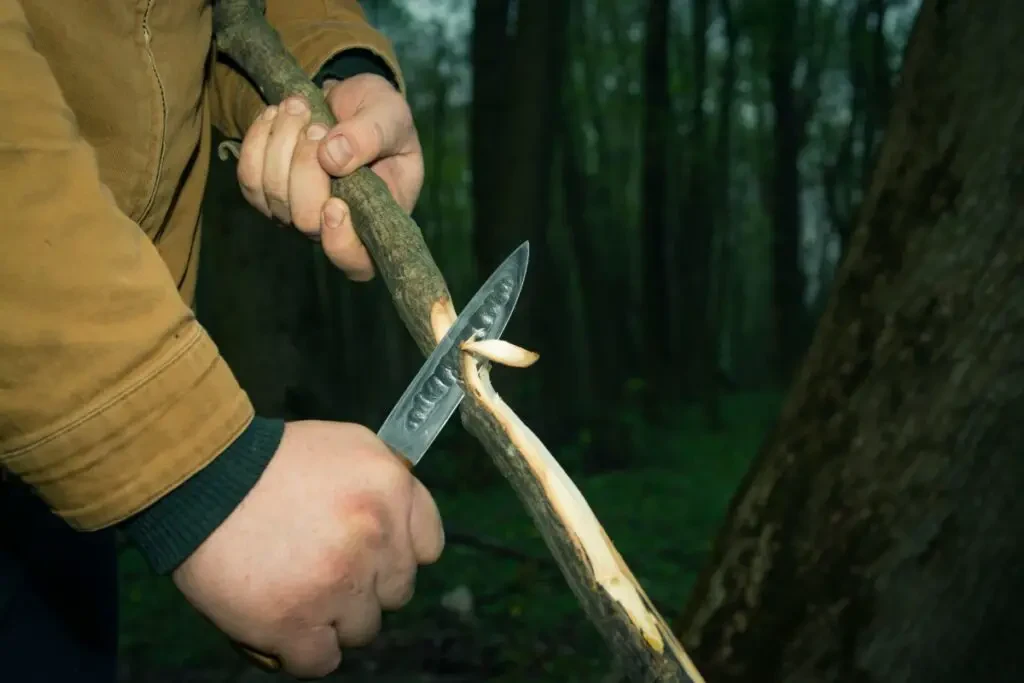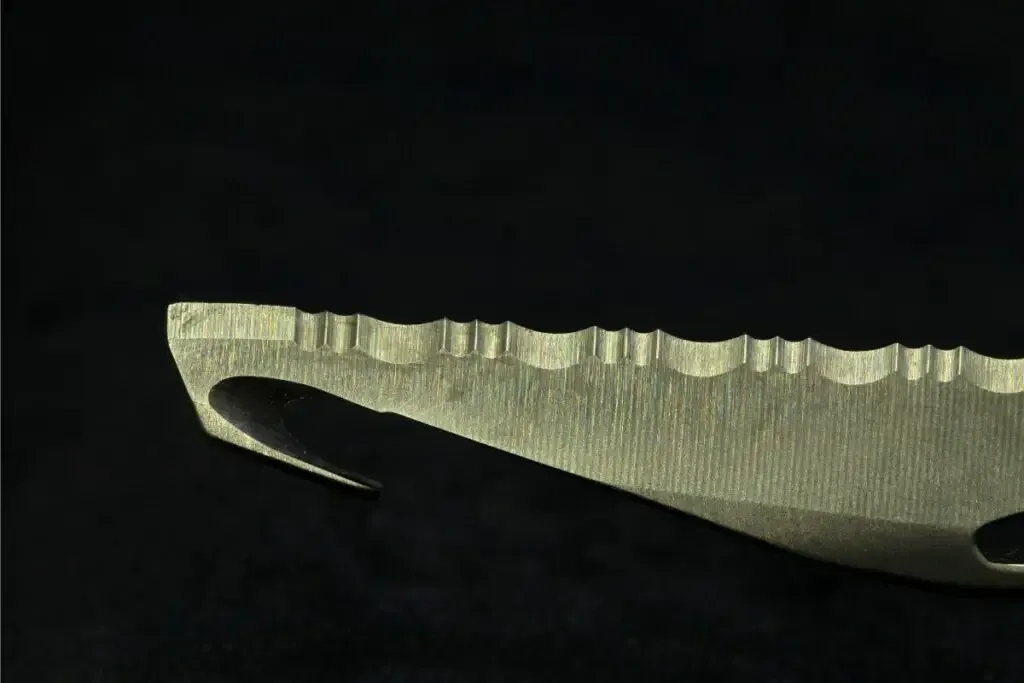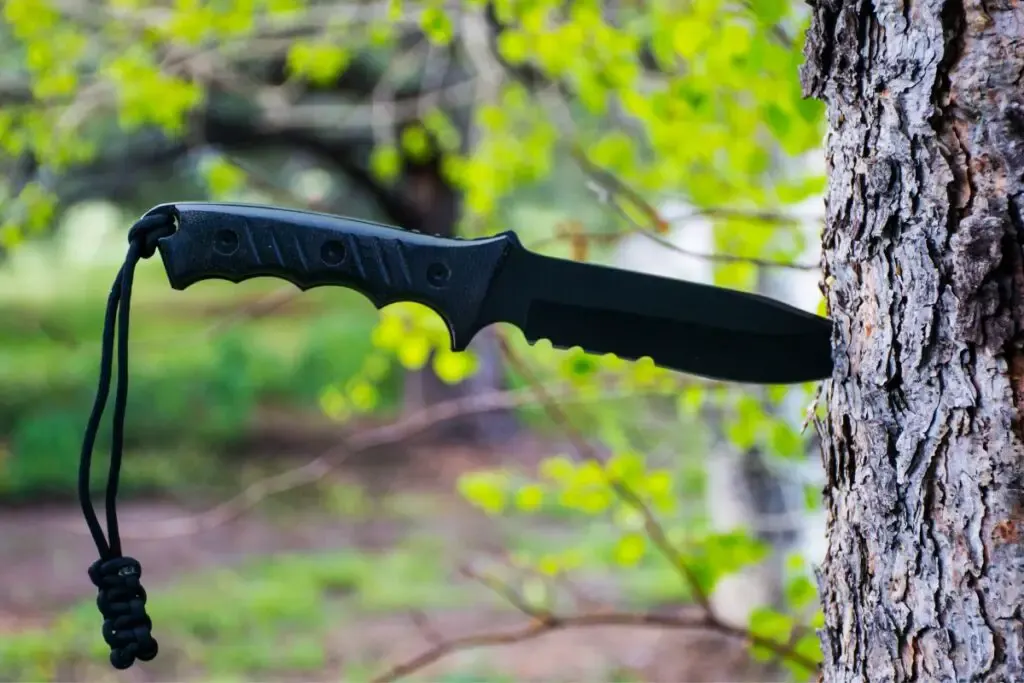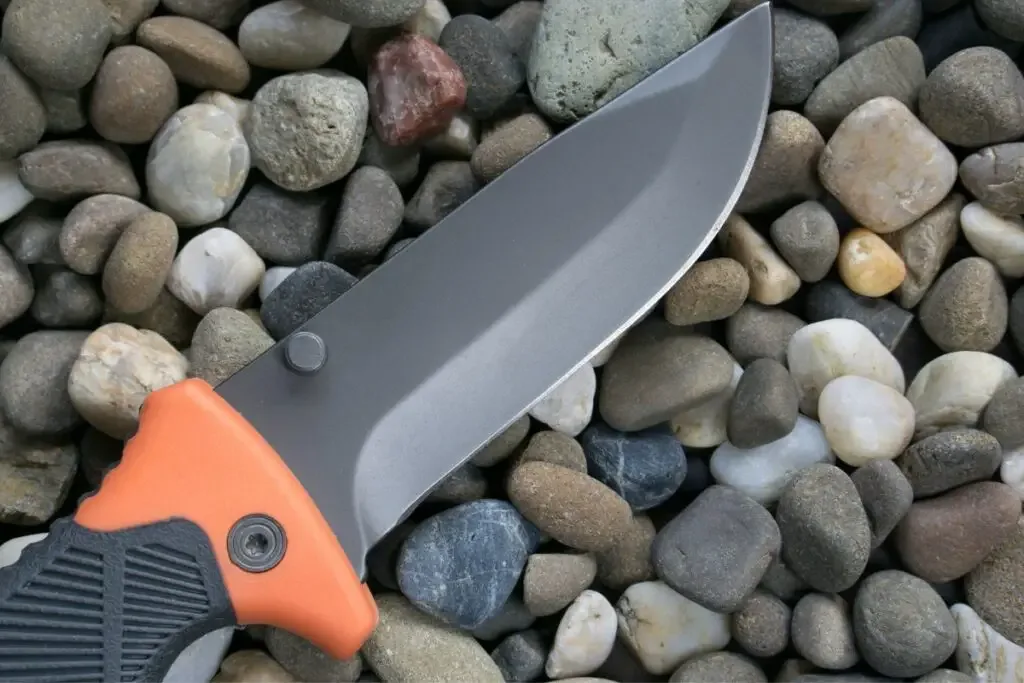As an Amazon Associate, we earn from qualifying purchases with no additional costs for you.
When engaging in survival and outdoor adventures, the tools you choose can make a significant difference between a successful expedition and a perilous ordeal. One of the most debated tools in this space is the survival knife, specifically the choice between a plain edge blade and a serrated edge. Both have their staunch advocates and valid reasons for preference. But when it comes down to the wire, which edge should you trust when your life might depend on it?
Serrated and plain edge blades have strong points and weaknesses when used in outdoor or survival situations. Serrated edges are good for ripping tough material and stay sharp for longer but are unsuitable for batoning firewood. Plain edges are better for these tasks.
We will discuss serrated edges on knives, providing insights, advantages, and practical scenarios to help you make an informed decision. Whether you’re a seasoned adventurer or just starting out, understanding the practicalities of your survival knife can be a game-changer. Let’s cut to the chase and explore the details of these two knife edges.
If you are interested in a serrated-edge survival knife that we use and highly recommend, take a look at this Spyderco fixed blade here. (Amazon Link)
Serrated Vs. Non-Serrated Survival Knife

When you’re choosing a survival knife, you’ll often come across two main types of edges: plain and serrated. There is a combination option that offers a partially serrated and non-serrated edge, but we will discuss that version separately.
Plain Edge Knife Blade
This type of knife has a smooth, continuous edge. It’s sharp when touched and is known for its versatility. Whether slicing an apple or carving wood, a plain edge offers precision and clean cuts. However, you’ll need to sharpen it regularly to keep it in prime condition.
Serrated Edge Knife Blade
Think of a bread knife, and you’ve got the idea. A serrated knife has saw-like teeth or edges. It’s great for tasks that require a sawing motion, like cutting through tough ropes or dense materials.
The teeth on the edge help grip and rip through objects, especially when wet or slippery, but there’s a catch. Sharpening a serrated knife can be a bit tricky due to its unique design.
The debate between plain and serrated is all about your needs and the tasks you’ll be performing. Both have their strengths and understanding them can help you make the best choice for your adventures.
An EDC survival knife (Amazon link) isn’t just any regular knife; it’s the one you carry with you daily, ready for unexpected challenges. It’s compact, reliable, and designed to handle a variety of tasks, from opening packages to emergencies.
The choice between a plain or serrated edge for your EDC can impact its versatility and your readiness.
While some prefer the precision of a plain edge for everyday tasks, others value the serrated edge for its ability to quickly cut through tougher materials. In essence, your EDC or survival knife is an extension of your preparedness, and its edge type plays a pivotal role in its effectiveness.
PRO TIP: We personally use diamond plates by Atoma. They are quite expensive but of the top quality with very long service life.
The initial costs are higher but you have an option of buying replacing diamond skin for all Atoma plates. The costs of replacing diamond skin are much lower than the cost of buying a new diamond plate.
So if you are going to use diamond plates regularly and want to get the best quality on the market, check out the four Atoma diamond plates listed below (Amazon links).
- Atoma Diamond Sharpener Coarse Grade 140 Grit
- Atoma Diamond Sharpener Medium 400 Grit
- Atoma Diamond Sharpener Fine 600 Grit
- Atoma Diamond Sharpener Super Fine 1200 Grit
These 4 diamond sharpening stones are all you need to have for repairing or sharpening your knives.
Advantages Of A Plain Edge Knife

A plain edge knife, distinguishable by its smooth and continuous cutting edge, boasts several advantages that make it a favorite choice for many outdoor enthusiasts and survivalists alike.
Superior Performance In Push Cuts
One of the standout features of a plain edge is its unmatched ability in push cuts. These are cuts where you push the blade through something, like when you’re slicing vegetables or carving wood.
The smooth cutting edge (Amazon link) allows for a clean, precise cut, making tasks like peeling an apple or whittling a piece of wood a breeze.
Versatility In Various Tasks
The plain edge is a jack of all trades. Its edge design is suitable for a wide range of tasks, from detailed work like skinning an animal to broader tasks like chopping wood. Its versatility is one of the main reasons it’s a go-to choice for many.
Razor-Polished Edge And Its Benefits
A well-maintained plain edge knife can achieve a razor-polished edge, meaning it’s incredibly sharp.
This level of sharpness ensures that the knife can easily and cleanly slice through materials, reducing the effort required and increasing efficiency. A razor-sharp knife also reduces the risk of accidents, as it’s less likely to slip or require excessive force.
Ease Of Maintenance And Sharpening
One of the undeniable advantages of a plain edge knife is how easy it is to maintain. Without the complexities of serrations, sharpening a plain edge is straightforward.
Whether you’re using a sharpening stone or a honing rod, you can achieve a sharp edge with minimal effort. Plus, regular maintenance ensures the knife’s longevity and consistent performance.
With its array of benefits, a plain edge knife is an invaluable tool for everyday tasks and specialized needs. Its simplicity, combined with its effectiveness, makes it a top choice for many.
TIP: Sharpening knives too often can cause them to wear out faster and reduce their effective lifespan. Read all about sharpening frequency in our article on the topic below.
Answered: Can Sharpening a Knife Everyday Ruin Your Knives?
Advantages Of A Serrated Knife

Serrated knives, easily identifiable by their toothed or saw-like edges, have carved out a niche for themselves in the world of blades. Here are some of the reasons why they’re favored by many:
Cutting Power Of Serrated Edges
One of the most notable strengths of a serrated knife is its exceptional cutting power. The toothed design excels at sawing through tough materials that a plain edge might struggle with.
Whether it’s a dense rope, a seat belt in an emergency situation, or woody-stemmed plants during a camping trip, a serrated edge knife can easily tackle these challenges, making it an essential tool in specific scenarios.
The Chisel-Ground Feature Of Serrated Blades
This unique feature of many serrated knives refers to one side of the blade being ground flat while the other is sharpened to a cutting edge.
This design enhances the knife’s cutting ability, effectively allowing the serrations to grip and rip through materials. The chisel-ground feature ensures that even when the knife starts to dull, the serrated edge remains effective, especially in tasks that require a sawing motion.
Aesthetic Appeal Of A Serrated Edge
Beyond functionality, there’s no denying the visual impact of a serrated knife. Its aggressive, toothed design gives it an intimidating appearance, which can be advantageous in situations where you might want to deter potential threats. The distinct look of serrated knives not only adds to their appeal but also signifies their specialized cutting prowess.
While serrated knives might not be the first choice for every task, they have undeniable advantages in specific situations. Their design and cutting capabilities make them valuable to any toolkit or collection.
Challenges With Serrated Edge Knives

While serrated knives have distinct advantages, they also come with challenges that users should be aware of.
Difficulties In Maintenance And Sharpening
One of the primary concerns with serrated knives is their maintenance. Unlike plain-edge knives, serrated ones have individual grooves and teeth that can make sharpening a more intricate process.
Specialized tools or techniques are often required to get into each serration, ensuring the entire blade remains sharp. This sharpening task can be time-consuming and requires a bit more expertise than sharpening a straight-edged blade.
Limitations In Tasks Like Batonning Wood
Batonning wood, which involves splitting wood by hammering a knife through it, can be tricky with a serrated knife.
The toothed design can get caught in the wood, making the process less efficient and potentially damaging the knife’s teeth. While it’s possible to baton with a serrated knife, it’s not ideal for the job.
Inability To Create Clean Cuts
The very design that makes serrated knives excellent for sawing through tough materials can be a drawback in tasks that require precision. The toothed design can lead to jagged or uneven cuts, especially in softer materials or tasks that demand a smooth finish.
For instance, if you’re trying to slice a tomato or carve a piece of meat, a serrated knife might not give you the clean, smooth cut you’re aiming for.
While serrated knives are invaluable in certain scenarios, it’s essential to recognize their limitations and challenges. Knowing when to use them and when to opt for a different tool can make all the difference in your tasks’ efficiency and outcome.
TIP: Find out my TOP 3 picks of pocket knives if you are interested in buying a pocket knife (Amazon link):
- Victorinox Swiss Army Rangergrip knife: Our favorite feature is the one-hand-opening lock blade, a crucial feature of this tool.
- Opinel No.8 Carbon Pocket Knife: Robust, reliable everyday carry knife, suitable for those who only want a knife blade on their pocket knife.
- Spyderco Para 3 Maxamet Pocket Knife: Lightweight knife featuring a blade made from high-performance Maxamet steel, with a full flat grind for edge durability and easy sharpening.
TIP: Sharpening a serrated-edge knife can be done DIY, but you need the right tools for the job. Read our article on how to sharpen these knives with or without a stone below.
DIY Guide: Sharpening A Serrated Knife With & Without Stone
Practical Scenarios: When To Use Which Knife

Understanding when to use a plain edge versus a serrated one can significantly enhance your efficiency and safety. Let’s explore some practical scenarios to shed light on the best choice for each situation:
1. Camping And Wilderness Adventures
- Plain Edge: Ideal for tasks like carving wood, preparing food, or skinning game. Its precision and clean cuts make it suitable for detailed work in the wild.
- Serrated Edge: Useful when you need to saw through tough materials, like branches or dense foliage.
2. Emergency Situations
- Plain Edge: Effective for tasks that require precision, such as cutting cloth for bandages or crafting makeshift tools.
- Serrated Edge: Essential for quickly cutting through seat belts, ropes, or dense materials to free trapped individuals or access essential items.
3. Kitchen Tasks
- Plain Edge: Perfect for slicing fruits, vegetables, and meats due to its clean and smooth cuts.
- Serrated Edge: Best for cutting bread or foods with a tough exterior skin and soft interior, like tomatoes.
4. Crafting And DIY Projects
- Plain Edge: Offers precision for detailed work, such as leather crafting or whittling.
- Serrated Edge: Useful for sawing through tough materials or when a jagged edge is not a concern.
5. Fishing And Marine Activities
- Plain Edge: Ideal for tasks like cleaning fish, cutting lines, or preparing bait.
- Serrated Edge: Comes in handy when cutting through wet ropes or nets, as the teeth provide a better grip on slippery materials.
6. Everyday Carry (EDC)
- Plain Edge: Suitable for a range of daily tasks, from opening packages to minor repairs.
- Serrated Edge: Useful for unexpected challenges that might require sawing or cutting through tough materials.
The choice between a plain edge and a serrated knife largely depends on the task at hand. By understanding the strengths and limitations of each type, you can ensure that you’re equipped with the right tool for every situation.
The table below is a quick reference summary of plain and serrated edge knives and their application for different tasks.
| Scenario | Plain Edge Uses | Serrated Edge Uses |
| Camping and Wilderness Adventures | Ideal for carving wood, preparing food, or skinning game. | Useful for sawing through tough materials like branches or dense foliage. |
| Emergency Situations | Effective for tasks requiring precision, like cutting cloth for bandages. | Essential for quickly cutting seat belts, ropes, or dense materials. |
| Kitchen Tasks | Perfect for slicing fruits, vegetables, and meats. | Best for cutting bread or foods with a tough exterior and soft interior. |
| Crafting and DIY Projects | Offers precision for detailed work, such as leather crafting or whittling. | Useful for sawing through tough materials or when jagged edges aren’t a concern. |
| Fishing and Marine Activities | Ideal for tasks like cleaning fish, cutting lines, or preparing bait. | Handy for cutting through wet ropes or nets due to better grip on slippery items. |
| Everyday Carry (EDC) | Suitable for daily tasks like opening packages or minor repairs. | Useful for challenges requiring sawing or cutting through tough materials. |
Conclusion
Choosing between a plain edge and a serrated knife isn’t merely about personal preference; it’s about understanding the specific demands of tasks and ensuring you’re equipped with the right tool for the job.
While a plain edge offers unparalleled precision and versatility for everyday tasks and detailed work, a serrated edge shines in situations that require aggressive cutting or sawing through tough materials.
By recognizing the strengths and limitations of each type, you can make informed decisions that enhance your efficiency, safety, and overall experience.
In the end, the best knife is the one that aligns with your needs, ensuring you’re always prepared, no matter the challenge.
TIP: Sharpening a serrated edge survival knife requires different tools and skills compared to a straight-edge blade. Find out how to sharpen a serrated knife in our comprehensive post on the topic.
How To Sharpen A Hollow Edge Knife In 5 Steps
